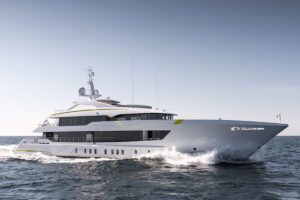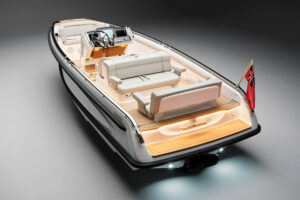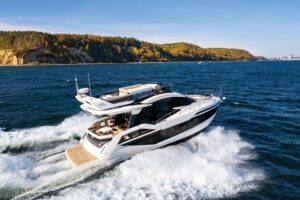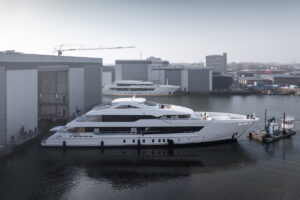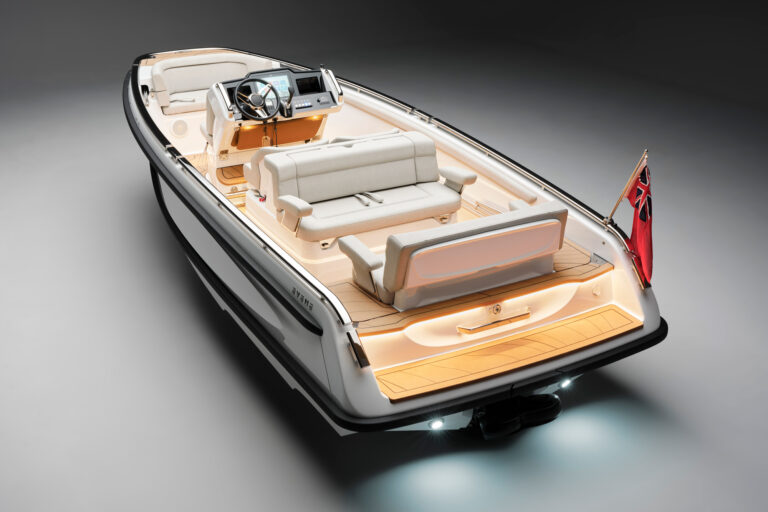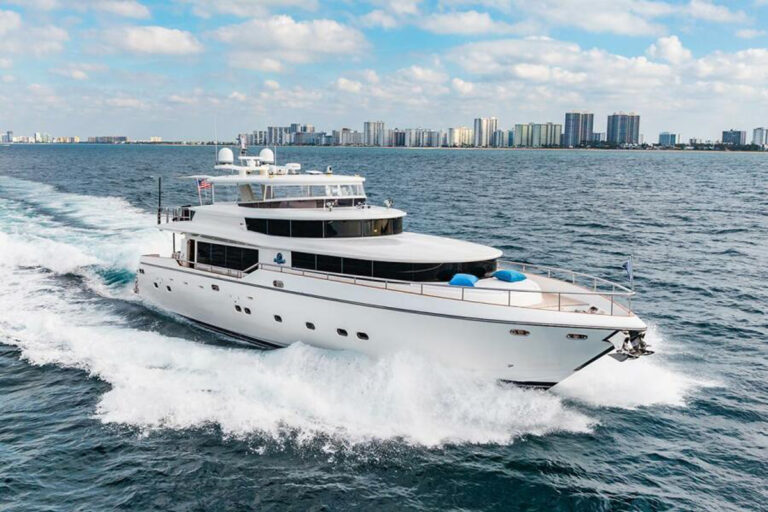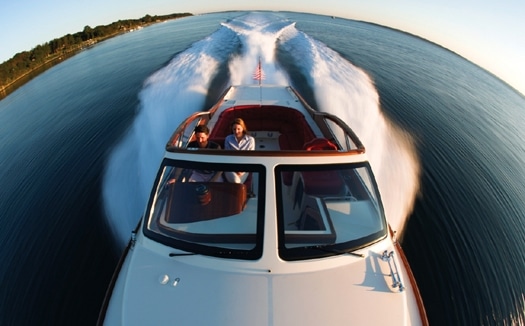
yachting/images/magazine/2006/122006/fea_hinckley3_525x326.jpg
The Hinckley T38R Convertible carves the surface of the water with streamlined grace and precision. Although the T38R takes to the water as if calved in some hidden sea by a pod of Orcas, it has a definite swagger, almost like that of a gunslinger. Maybe not John Wayne, maybe more Antonio Banderas in Desperado-speaking softly and carrying a big stick, and making all the women sigh and swoon with longing.
Let’s just say this stylish runabout has soul-and it should stir yours. I can attest to this boat’s simple presence at the dock, snuggled up against fenders, drawing a crowd at the marina. And before you raise or lower the hydraulically operated convertible top-yes, just like you would in a sports car-you might want to have your public relations person with you to answer questions.
Collaboration between Hinckley and the Setzer Design Group produced this lovely runabout, which seems destined to nestle beside some superyacht mothership when she’s not exploring her owner’s favorite private beaches. Indeed, Ward Setzer and his team made their reputation designing big boats and megayachts and have only during the past couple of years branched into relatively small boats. The T38R is Setzer’s first for Hinckley.
Such collaborations are rarely easy, and in this case Setzer had a tough act to follow-Bruce King and the line of Talaria models he drew. First and foremost in designing the T38R, Setzer had to retain the identity of the earlier models in the current Talaria line, which began life with the Picnic Boat, while at the same time drawing a unique boat of his own. King had played with the basic style of New England’s working lobster boats and hard-fished bass boats, finally massaging the basics into a softer, more elegant style than displayed by the originals. That’s why to refer to any of the Talaria models from King’s office as a lobster boat is to do it a serious injustice.
With this as a background, the T38R comes into focus. Her closest kin is King’s T29R and like that boat, the T38R is all about curves, shadows, highlights and reflections. The bow of the T38R stands proud, and the sheerline sweeps gently aft, becoming nearly parallel to the waterline at the afterdeck. A teak caprail and the chine rising from the static waterline in the forward third of the hull disguise the height of the topsides as we look at the boat’s profile. Move forward or aft to catch a three-quarter view, and you’ll see a completely different boat. Tumblehome at the stern and the exquisite plunge of the cockpit coaming recall the lines that Carlo Riva made famous in the late 1950 and early 1960s on his mahogany runabouts.
From the after quarter, the T38R seems smaller than she is. If we move forward of abeam, we see another aspect of her personality. Her dramatic flare and spoon bow show her aggressive side, one that hints at speed and seaworthiness. Her artfully curved windshield and side windows make us think about the fine sports cars we’ve seen and loved over the years.
She’s not devoid of compromise, though. In order to make the interior truly usable, the design team had to add a trunk cabin forward of the windshield. This provides enough headroom below to accommodate all but the tallest persons-a good thing-but the structure intrudes ever so slightly on the T38R’s beautiful profile. Never mind, she remains one of the loveliest boats of her type ever to hit the water, and the design team should be proud of their accomplishment. Pulling together all of these elements into such a harmonious whole demanded artistic sensitivity and an open mind. Bravo!
If any single element distinguishes the T38R from all of the open boats of this size, her convertible top gets the nod. Skeptics may be tempted to dismiss it as a gimmick, but they’d be mistaken. This hydraulically operated fabric-over-frame top is a big idea whose time has arrived, and after you see it operate, you’ll wonder why someone didn’t attempt it years ago. Retracted, the top hides in a snug cavern abaft the cockpit. When you want shelter from the sun or rain, you open two small fiberglass panels on each side of the cockpit at about amidships. Next, push a button on the dashboard. The fiberglass hatch lifts on hydraulic pistons and the top begins its deliberate arc toward the windshield.
I was too captivated to have timed the sequence, but I’ll wager the entire process-from lifting the four panels to latching the top to the windshield-takes less than a minute. What’s more, the pins and locking devices hit their marks dead center atop the windshield. Turning a couple of handles locks the top into place, exactly as it does on your Maserati. A variety of sensors in strategic locations shut down the process if someone places a hand in dangerous proximity to the mechanism or the operator pushes the button out of sequence. When the top is up and secured, the gleaming stainless steel framework likely will dominate the conversation until everyone gets used to its intricacy and high quality. Side curtains zip into place and snap to the superstructure to cope with crosswinds and rain. Another curtain zips onto the back of the top to completely enclose the cockpit. During sweltering summer thundershowers, the optional air-conditioning piped into the cockpit should keep everyone cool and dry.
So, open the champagne and relax until the front passes, because “dayboat extraordinaire” sums up the T38R’s purpose in life. The cockpit holds 10 adults without crowding. The red leather upholstery, treated for water-resistance, glowed in the misty bright overcast day of my sea trial. The color perfectly suits the boat, but conservative buyers may want something darker, or maybe neutral. Hinckley gladly will accommodate their wishes. Buyers also may specify the optional sink and icemaker abaft the companion seat, which shortens the portside lounge.
As I clambered aboard the T38R from the float, I cringed at having to step on the upholstery. I failed to notice the boarding step beneath the cushion in the corner. Hinckley has provided a boarding step at each turn of the U-shape seating back aft. Removable cushions cover the steps to complete the seating package, though I like the look of the cockpit when the steps are exposed.
A recessed sunpad over the engineroom back aft has space for two sun worshippers, who may bake in safety, because the motion back there is minimal and the recess quite deep. The pad on the port side folds along the center to provide a passageway between the swim platform and the cockpit. The entire area lifts hydraulically to reveal a relatively roomy engineroom/machinery space. Easy access to the engines ought to encourage owners to make routine daily checks.
Hinckley and Setzer devoted about two thirds of the T38R’s LOA to outdoor space, as befits a dayboat, yet only compromised the cabin a little. If you accept the boat’s premise, the cabin is close to perfect for a loving couple to spend a night or weekend. Descending the companionway leads you into a satin-finished cherry delight of raised-panel doors on the lockers, ceilings outboard of the V-shape settee, glass-panel doors over the galley and louvered doors on the lockers in the head. The ambiance recalls that of Setzer’s big boats. The settee dominates the accommodations, and at first glance seems too short to be used as a berth; removing two cushions at the narrow end of the “V” lengthens each leg of the settee and, voila, you have a pair of full-size singles. A small table of glossily varnished teak fills the wide end of the “V” and turns the area into a cozy spot for dinner a deux.
Although I would have been content to spend an hour or two chatting about boats and the marine industry with Hinckley’s Ed Roberts, time was short and we had a mission-to see if the T38R’s performance matched her good looks. Roberts fired up the Volvo Penta D-6 diesels and let them murmur to themselves for a few minutes while we prepared to cast off. These electronically controlled common-rail engines are remarkably smooth and quiet, announcing their presence in much the same way that the 6.3-liter V-8 in the Mercedes CLK63 AMG Cabriolet speaks to its driver. “Yes, we’re powerful, but no need to make a fuss about it.”
JetStick in hand, Roberts eased the boat out of her slip and headed her toward the mouth of the harbor. In docking mode, the JetStick gives the helmsman uncannily intuitive control over 18,000 pounds of boat and a combined total of 870 horsepower. A twist here and a nudge there orchestrate thrust from the Hamilton Jets and the bowthruster, placing the boat as precisely as you please. Adapting to the JetStick takes tyros only several minutes.
On the open waters of Narragansett Bay between Portsmouth and Prudence Island, Roberts put the T38R into hovering mode and motioned me to the helm. Pushing the red button, which returns control to the helm, I opened the throttles and accelerated us toward Newport. Jets wind up the way the torque converter of your car’s automatic transmission does. In the early days of high-volume low-pressure jet drives, this characteristic drove me crazy. Continuous development has nearly eliminated the slushy response, bringing the latest iteration of jet drives as close to that of props as we’re likely to see in our lifetime. That little bit of slippage is a small price to pay for the extraordinary control the jets-and the JetStick-provide.
In no time at all, we closed on 38 knots, and the T38R felt at one with the water, slicing across the surface like a sport boat. As the wind increased and fanned a modest chop on the surface of the bay, the Hinckley shrugged and punched her way through, tossing spray aside and absorbing the shocks. She steered accurately, returning just the right amount of feel to the wheel to keep me in tune with my steering inputs. Helm hard over, I cut a couple of sharp turns at top speed. The boat leaned reassuringly into the turns, her bottom digging in and holding the course. She didn’t skid in the slightest and scrubbed off only a few knots of speed.
While the T38R hustled through my routine, I sat on the helmsman’s seat, which is high enough to have given me a clear view of the water in front of the boat. At 5 feet 6 inches, I’m too short to get the same view by standing at the wheel, and I’m happy to report that the seat is very comfortable. Although it adjusts fore and aft, the height is fixed, primarily because Hinckley didn’t want to sacrifice the stowage area beneath the seat by switching to a pedestal. (Roberts said that Hinckley is working on an adjustable riser for us height-challenged pilots.) The lack of buffeting from our apparent wind surprised me and proved that form-in the shape of the windshield and side windows-has followed function.
The Hinckley’s buttoned-down ride and handling come in part from her stiff structure. Hinckley DualGuard Composite Construction-Kevlar/E-glass outer skin, aircraft-grade end-grain balsa core below the waterline, and a carbon inner skin set in epoxy resin and laminated via the resin infusion method-is responsible for the structural integrity and reasonable weight. Her deep-V hull completes the equation.
Dayboats come and go. Some of them are extraordinarily good-looking and delightfully competent, which guarantees them a long production run and second, third and fourth lives after the original owner sells. A few of these small boats, though, will become icons. Will the Hinckley T38R Convertible be one of these? It’s a good bet.
Contact: Hinckley Yachts; www.hinckleyyachts.com

